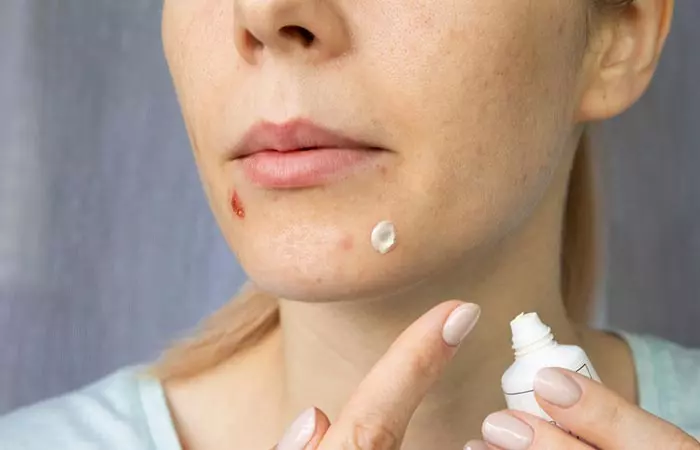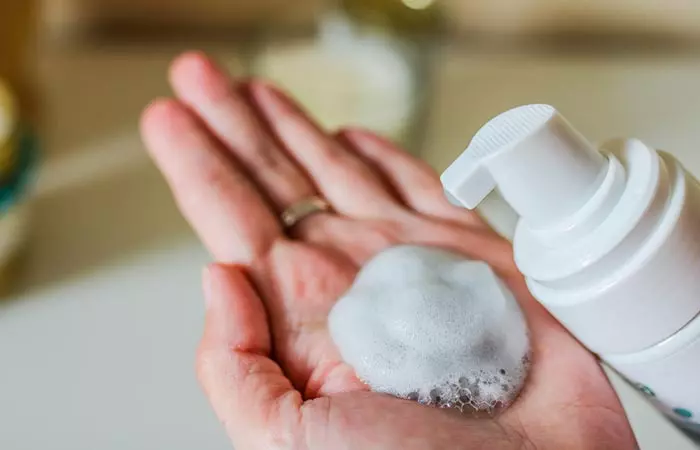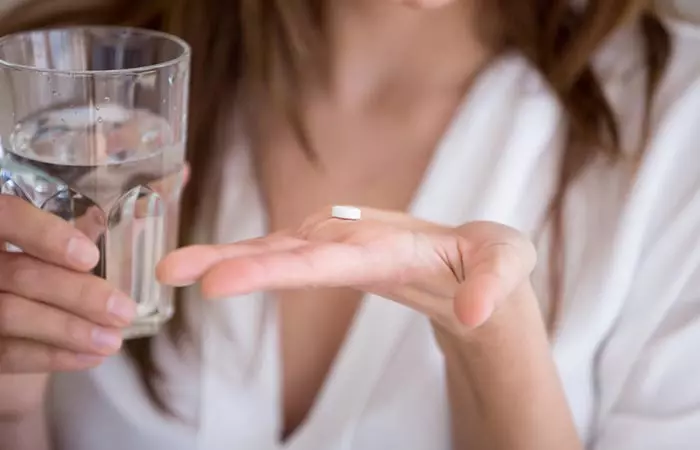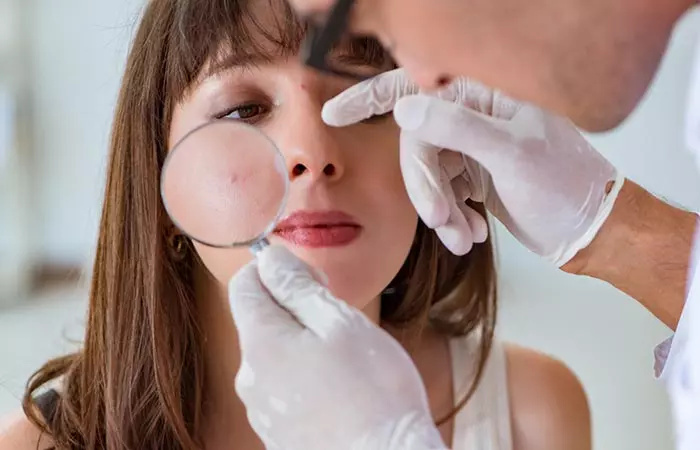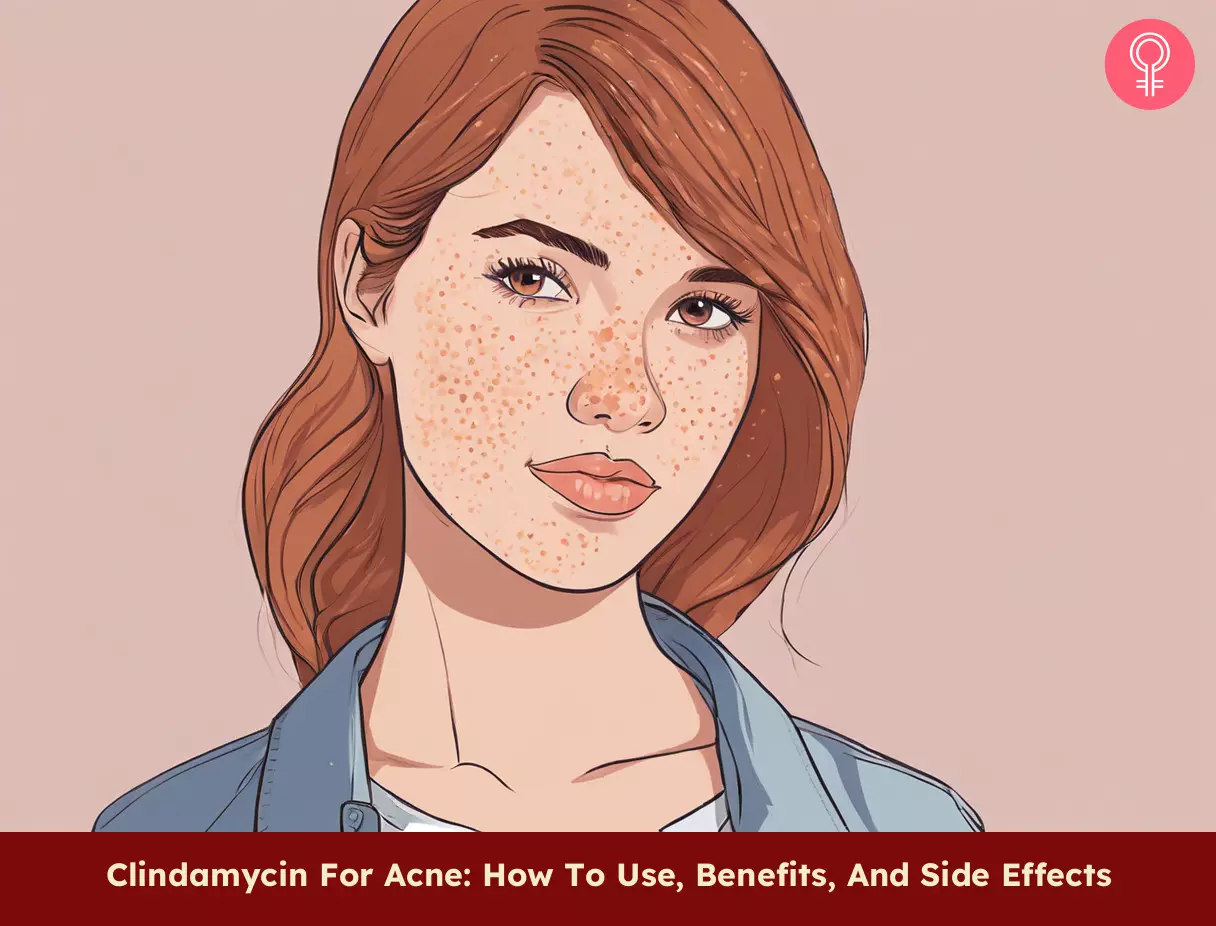Clindamycin is available in foams, gels and solutions. You can use any of them based on your preference and tolerability. This article discusses the effectiveness of clindamycin, how to use it to treat acne, and potential side effects. Keep reading!
Benefits Of Using Clindamycin For Acne
A 2007 study showed that clindamycin was more efficient than other topical antimicrobials like erythromycin and tetracycline in treating acne (1). Another study suggested that a nano gel emulsion made with 1% clindamycin was more effective in treating acne than other conventional gel formulations (2). Research has also evaluated the effects of topical clindamycin hydrochloride and clindamycin phosphate (2% concentration for both) in treating acne. They were compared with two non-prescription, anti-acne hydroalcoholic products (3). After eight weeks, the clindamycin formulations proved to be better for patients with moderate to severe acne. However, the study highlights the possibility of a placebo effecti A state where the mind convinces the body that a pseudo treatment is valuable and real and, thus, stimulates healing. in this regard. Topical clindamycin reduces the count of bacteria, like propionibacterium acnes, in sebaceous folliclesi Glands around the hair follicles that produce a waxy and oily substance called sebum to protect the skin’s surface. by disrupting their growth. Pairing a topical antibiotic, like clindamycin, with benzoyl peroxide reduces resistance in the bacteria. These antimicrobials suppress the growth of propionibacterium acnes that is known to cause acne (1). Panna, a blogger, shared how she deals with oily and breakout-prone skin and her hesitation to use products that might worsen the condition. Her dermatologist recommended using a product that contained clindamycin. She writes, “It is not too thick nor too thin, it has the perfect gel-like consistency and is quickly absorbed in the skin. By far this is the best product that I have used and it has worked really well on my skin… I have been using this product for the past month, and I can see the effect myself (i).”
Combination Therapies Using Clindamycin
A combination treatment of 1.2% clindamycin phosphate paired with 3.1% benzoyl peroxide and 0.15% adapalene is fast acting and can reduce both inflammatory and noninflammatory acne in people with moderate-to-severe acne. The graph below displays the decline in inflammatory and noninflammatory lesions brought on by the topical use of this triple combination gel over a period of 12 weeks.
Least-Squares (LS) Mean Percent Reductions In A Inflammatory Lesions And B Noninflammatory Lesions
Clindamycin can be used differently depending on the severity of acne. However, it cannot effectively treat acne by itself. Using it with another antimicrobial treatment may bring desired results. Variations of topical clindamycin paired with benzoyl peroxide have shown promising results in treating acne. This combination treats inflammatory and anti-inflammatory acne. A study showed that using an aqueous gel made with 1.2% of clindamycin phosphate and 3.75% of benzoyl peroxide proved effective in treating moderate to severe acne (3). The topical application of 1 to 4% of clindamycin and erythromycin, in combination, with or without zinc, could effectively treat inflammatory acne (4). Clindamycin phosphate (1.2%), paired with 0.025% of tretinoin and applied as an aqueous gel, had also shown to be effective (5). The combination may also reduce acne lesionsi Abnormal growths in tissue within or on the skin caused by trauma or disease that changes the appearance of the affected area. more effectively than clindamycin monotherapy (6). On this note, you may also read about the usage of tretinoin for acne and its benefits and side-effects. Clindamycin is clearly beneficial in acne treatment. But how exactly do you use it once prescribed by your doctor?
How To Use Clindamycin For Acne
Be aware that some formulations like topical foams may contain alcohol that might sting or burn when applied to the skin. Wash your face and apply the foam with clean hands on all acne spots and blemishes. As mentioned above, there are many combination therapies that a doctor might recommend for treating acne (such as pairing clindamycin with benzoyl peroxide or with a topical retinoid). The doctor may prescribe any of the combinations depending on the severity of acne breakouts. Do not discontinue using clindamycin even if the acne starts to improve. Complete the full course as prescribed by the doctor. Once the course is completed, the doctor might ask you to stop using topical clindamycin and continue other medications. Sometimes dermatologists prescribe oral clindamycin, an antibiotic that reduces the number of acne-causing bacteria on your skin. The dosage and duration depend on specific instructions of the healthcare provider. It is usually taken as a capsule or tablet. However, oral antibiotics are typically reserved for more severe cases of acne. They can be effective, but they also come with potential side effects. Moreover, their long-term use can lead to antibiotic resistance, which is not desirable. As with any treatment, the possibility of side effects after using clindamycin cannot be ruled out. We discuss the potential adverse effects of clindamycin in the next section.
Side Effects
Clindamycin is considered safe. However, in some cases it may cause side effects like (4).
Erythemai Mild skin redness caused by an infection or certain medicines in some parts or all over the body. Peeling Itching Dryness Burning Pseudomembranous colitis (inflammation of the bowel’s inner lining)
While the safety of chronic use of clindamycin during pregnancy still needs to be determined, its short-term use is considered safe. Research shows that it can be used in combination with other medications for treating acne in pregnant or lactating women (7). Pregnant women can use topical clindamycin and benzoyl peroxide to treat mild to moderate acne. However, clindamycin gels, lotions, solutions, foams, and swabs are not recommended for use as monotherapy. A combination of 1% clindamycin and benzoyl peroxide gel (of either 1%, 5%, 1.2%, or 2.5% concentration) may be used in patients with gastrointestinal diseases after consulting the doctor. Clindamycin may cause clostridium difficile diarrhea (colon inflammation) in such individuals. Clindamycin may rarely cause side effects in some individuals. Hence, the doctor may prescribe alternatives like antibiotics and retinoidi A chemical compound derived from vitamin A that is used in cosmetics because of its anti-wrinkling and anti-aging properties. creams. Keep reading.
Alternatives To Clindamycin
Antibiotics are normally prescribed for treating mild to moderate acne. Topical retinoidi A chemical compound derived from vitamin A that is used in cosmetics because of its anti-wrinkling and anti-aging properties. creams may be used for blackheads whiteheads, or pimples. Combination therapies of antibiotics and retinoidi A chemical compound derived from vitamin A that is used in cosmetics because of its anti-wrinkling and anti-aging properties. creams may be suggested for treating moderate to severe acne breakouts. You can also try skin peeling for acne to clear your skin as an alternative to clindamycin. Treatments like chemical peels remove dead skin, unclog pores, and reduce acne, making your skin smoother. Consult a dermatologist to find the right peel for your skin type. After the peel, remember to take care of your skin and use sun protection to get the best results. Many home remedies are often suggested on various blogs. But they may not be as effective as medication. Certain home remedies might not work on particular skin types, and may instead cause further breakouts by accumulating sebum into the pores. While a few over-the-counter medications can also be used, make sure to consult a doctor first.
When To See A Doctor?
If the existing treatment is not working or causing breakouts, the solution may lie in other treatments informed by dermatology, and you should consult a dermatologist immediately. It might be because of a bacterial infection in which the microbes may have developed antibiotic resistance. According to the 2019 Antibiotic Resistance Threats Report by the CDC, Group B Streptococcus (GBS) is a bacterial strain that can lead to serious illnesses, including skin infections. In 2016, there were approximately 31,000 severe GBS infections, resulting in 1,700 deaths. Alarmingly, over 40% of these GBS infections were caused by strains resistant to clindamycin (43% in 2015 and 42% in 2016), which restricts the treatment options for individuals with a severe penicillin allergy. Consult a doctor before using any creams or oral supplements to treat acne. Inform your doctor about your regular skincare routine and the frequency of your breakouts. They will accordingly suggest a plan of action. You might notice an improvement in your skin condition once you start using the medication. Use the medication as prescribed. Do not discontinue it beforehand. How long does it take clindamycin to work for acne? It may take 8 to 12 weeks for clindamycin to work for acne. However, you will start seeing improvement in your skin within 4 weeks. How often should you use clindamycin for acne? It is recommended to use topical clindamycin two times a day. You may also consult your doctor for the correct dosage. Can I put moisturizer over clindamycin? No, for better results, it is recommended to apply clindamycin over moisturizer. Can I use clindamycin every day? Yes, you must use clindamycin every day to treat acne issues.
Illustration: Clindamycin For Acne: How To Use Benefits And Side Effects
Clindamycin is an antibiotic that can be very effective in the treatment of acne. Click on this video to learn how it works and what it can do to help clear up your skin.
